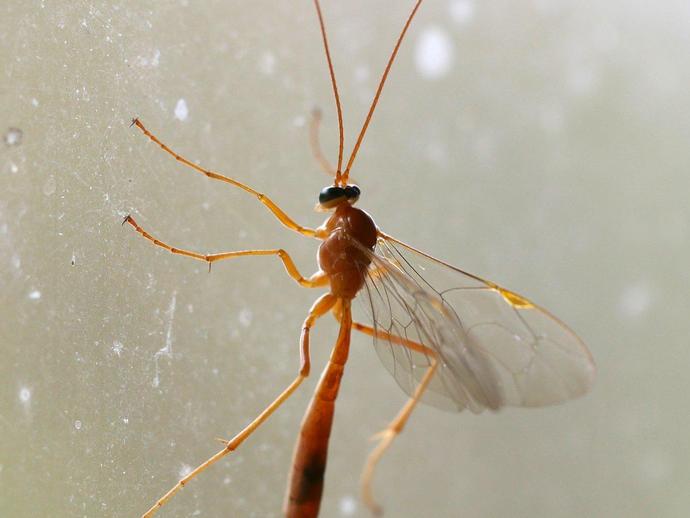November 20, 2020
It's time for the Friday edition of #BenInNature! It's always amusing to me (in a deeply frustrating way) to see how the media often covers insects. A handful of Asian giant hornets are found in the Pacific Northwest and headlines suddenly scream that "murder hornets" are invading the U.S. A few venomous puss caterpillars are found in Virginia -- which is within their range -- and you see headlines about these horrible caterpillars "suddenly" appearing in Virginia. And when I was looking up information on this ichneumon wasp, which belongs to the genus Netelia, one of the first links I found was a news story proclaiming that "Zombie bugs invade region," which ends with a quote from a lady saying that she hopes the wasps don't lay eggs on her while she's sleeping.
This particular wasp is not a zombie, nor is it invading anything, but it is pretty cool! Ichneumons are an enormous family of wasps with more than 25,000 described species, although it's believed that is just a fraction of their true diversity. What almost all ichneumons have in common is that they're parasitoids, which means that they have a close association with a host species that generally results in the host's death. For ichneumons, the host is generally the immature stage of an insect or spider, and the nature of the association is similar to that of John Hurt and the alien that burst out of him in the movie "Alien."
This specific ichneumon belongs to the genus Netelia, and they are generally ectoparasitoids of moth and butterfly caterpillars. A female wasp will use its ovipositor to sting a caterpillar and temporarily paralyze it. She then uses the ovipositor to affix an egg to the outside of the caterpillar's body. Once the egg hatches, the wasp larva will slowly eat the caterpillar alive, resulting in the caterpillar's eventual demise.
While this is obviously unpleasant for the caterpillar, we humans don't have to worry about any ichneumons injecting us with eggs while we sleep, no matter what you may have read elsewhere.
Thank you to VMNH Associate Curator of Recent Invertebrates Dr. Kal Ivanov for the ID!
ABOUT #BenInNature
Social distancing can be difficult, but it presents a great opportunity to become reacquainted with nature. In this series of posts, Administrator of Science Ben Williams ventures outdoors to record a snapshot of the unique sights that can be found in the natural world. New updates are posted Monday - Friday, with previous posts highlighted on the weekends.
NEW: TRIVIA CHALLENGE
You've seen the posts. You've learned the facts. Now, it's time to prove you are a #BenInNature Mega Fan! The museum's education team has developed the #BenInNature Trivia Challenge to identify the most devoted fans out there! Everyone who successfully answers each trivia question correctly will be congratulated by having your own nature selfie posted to the museum's #BenInNature Mega Fan Photo Album on the official VMNH Facebook page! Learn more and download the trivia challenge today by visiting www.vmnh.net/research-collections/beninnature-trivia-challenge.
NATURE PHOTO IDENTIFICATIONS
If you discover something in nature that you would like help identifying, be sure to message us right here on Facebook with a picture (please include location and date of picture) and we'll have our experts help you identify it!

 Hours & Admissions
Hours & Admissions Directions
Directions

